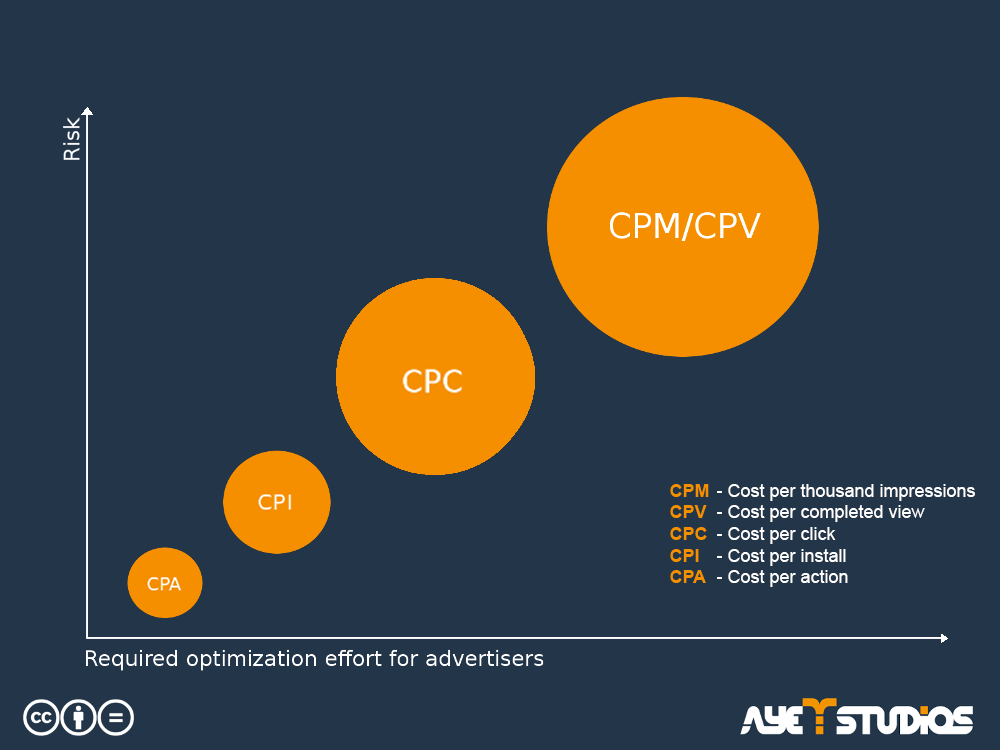When developing an app, you should think about pricing in advance and how much it will cost to lead users to your app. There are some cost models regarding mobile media pricing you need to know if you calculate how much it costs to generate users for your app.
If you are new to this field, you may be confused by all the abbreviations that the marketing agencies have developed for the wide field of mobile media pricing.
Don’t worry: In the following, we will explain all of them.
The Most Common Mobile Media Pricing Models
Advertising within other apps is a common way to drive users to your app in the app stores. How much budget advertisers have to invest for a specific campaign type depends on the approach to the user.
In this article, we want to show you the different “C”-types in mobile media pricing. These will guide you and make it easier to choose the right campaign type to lever your app in the app stores.
A Short Introduction
The picture below shows the advertiser risk compared to the scale you can reach with the respective mobile media pricing model. Let’s dig a little bit deeper:
-
- CPA is the most risk-free mobile media pricing model for advertisers. That’s because no matter how good or bad a publisher’s audience actually is, the price is already set on the conversion.
It doesn’t matter if the publisher needs 1,000, 10,000 or even 100,000 impressions to deliver a single conversion, because he/she will pay for just the one single conversion delivered.
Whereas, the publisher would have sold his 1,000, 10,000 or 100,000 impressions for much different prices. - CPM is the most risky mobile media pricing model for the advertiser, or, in turn, the most risk free model for publishers.
The advertiser doesn’t know beforehand how many impressions he/she has to buy in order to generate a single conversion. If he/she needs 1,000 instead of 10,000 or 100,000 impressions to generate a conversion, it will result in 10 or 100 times higher conversion costs.
Whereas the publisher will sell his 1,000, 10,000 or 100,000 impressions for the same CPM, i.e. for $5 per 1,000 impressions. - To summarize, CPA is risk free for advertisers and CPM is risk free for publishers.
Moving along the imaginary line of those two mobile media pricing models from CPA to CPM will lead to a shift away from publisher risk towards advertiser risk.
- CPA is the most risk-free mobile media pricing model for advertisers. That’s because no matter how good or bad a publisher’s audience actually is, the price is already set on the conversion.
Risk to optimization effort for advertisers © ayeT-Studios
If you want to get to know more about mobile user acquisition, click here.
In order for you to fully understand the above mentioned correlation, let’s take a closer look at the different C-Types for mobile media pricing.
CPI – Cost Per Install
(also referred to as CPD – Cost Per Download)
This model of mobile media pricing is special for mobile apps, where you only pay for completed installs. This type of advertising is a proven tool for generating a lot of installs in a short period of time.
The problem is: Users might only install your app to get the reward and not interact with it at all. You need to be aware of this as an important factor for your mobile media pricing strategy.
CPA – Cost Per Action
In the mobile and online marketing sector, this is a common model for billing. The publisher only rewards the user if he/she fulfills specific predefined actions.
Depending on the underlying asset, it can result in an order or sale, which ultimately results in being the same mobile media pricing model as Cost per Sale or Cost per Order.
For the mobile advertising industry, this pricing type is more commonly used for setting actions like completing a tutorial, reaching a certain level, registering an account or subscribing to a newsletter. The defined paid action for this type of mobile media pricing can be as specific as needed.
But keep in mind: Rewards should either come frequently (if there should be more than one) or not too late if there is just one.
CPE (Cost-per-engagement or multi-reward) campaigns, which are offered by ayeT-Studios, are a combination of 2 mobile media pricing models: CPA (Cost Per Action) and CPC (Cost Per Click).
This campaign type is not clearly defined. It is a loose term for any interaction of the user with an ad. So engagement could mean anything, even closing an ad, or stopping it from playing a video.
The idea arose from the theory that the hardest point to achieve is to get the attention of a (potential) customer.
So in most cases the advertiser defines the engagement he wishes the user to do and pays for that, e.g. clicking an ad.
Nowadays, the term is synonymously used with CPA concerning mobile media pricing: You set an action or engagement goal for the user, upon which completion you have to pay the publisher.
CPC – Cost Per Click
As the name indicates, with CPC campaigns, the app owner only pays when an ad is clicked.
This is an efficient and frequently used method of advertising for two reason:
-
- It allows advertisers to calculate with high security what they will receive in return for their ad spend.
- Estimated revenue per million impressions is much more predictable for publishers.
It is fair for both parties:
- Advertisers only pay when a customer engages with (clicks on) an ad
- Publishers don’t carry the risk of users not engaging after clicking an ad (unlike with formats like CPI, CPE or CPA).
With the data you get from this method you can do some simple calculations, like how many clicks you need in order to generate a download or sale.
When calculating with such a campaign type: Keep in mind to consider “accidental” clicks, too. It will happen more often for this kind of mobile media pricing.
CPM – Cost Per Mille / Million
This form of mobile media pricing is the oldest one and has its roots in classical marketing. However, it also continues in the era of mobile and online marketing.
The term “million” originates from the french word “mille”, meaning “thousand”. CPM means that you pay for every 1000 impressions of your ad – Cost Per Million Impressions.
This is a good mobile media pricing method to build and raise your brand recognition because you are able to get large volumes on real-time bidding networks.
eCPM – Effective Cost Per Million
This metric is designed for publishers. If a publisher sells his/her available ad space with different mobile media pricing models, i.e. CPM, CPC and CPI, he/she will ultimately want to compare the efficiency of the pricing models to each other.
In order to do that, pricing types like CPC, CPI or CPA will be converted into eCPM, making them comparable to each other.
The higher the eCPM, the better is the specific mobile media pricing type in order to sell your ad space at highest rate.
CPV – Cost Per Completed View
This mobile media pricing model is based on users viewing the entire ad, commonly a video clip. You are more likely to benefit from this kind of ad if you build or manage a brand.
Make sure the video is interesting and please keep in mind that a certain point within the video is set for which the video counta as a completely viewed. This doesn’t necessarily have to be the whole video.
If you do not only want to know which mobile media pricing model to use, click here to find out which ad formats there are and how to use them.
M-Commerce: Another Industry Requires Other Mobile Media Pricing Types
M-commerce (mobile-commerce) is the selling and buying of services and goods with the help of mobile devices like smartphones and tablets.
Advertisers can create campaigns that target customers to buy their products directly from the mobile device he or she is using.
Remind yourself to keep the funnel short, so it is very easy for the customer to spend their money. Here are some specific types of mobile media pricing for this industry.
CPO – Cost Per Order
This type of mobile media pricing (also called CPS – Cost Per Sale) is very similar CPA because the publisher defines a specific action the user has to fulfill before the advertiser gets paid.
The main difference to CPA is that publishers only get paid once a transaction is completed sucessfully.
CPL – Cost Per Lead
This mobile media pricing model (also called PPL – Pay Per Lead) rewards the publisher based on some form of registration or subscription by the user.
A lead is usually generated when the user subscribes for a newsletter or registers an account on an e-commerce website.
Less Common Media Pricing Types for Special Ad Campaigns
Aside from the mobile media pricing types and the ones for m-commerce, you are able to find less common models.
Pay-Per-Call
In this ad type, the customer will be connected with the customer support automatically if he/she clicks the ad.
Email Newsletters
This is one of the oldest mobile media pricing models for digital advertising: You can create an ad which guides a user to subscribe to your (periodic) email newsletter.
Click-To-Text
You can also create an ad, which activates an automated SMS service to keep the user informed about publisher’s products.
Which Model of Mobile Media Pricing Fits the Best?
There are many different ways to approach potential users and to measure the effort you put in.
We at ayeT-Studios are a very experienced team and can help you choose the right mobile media pricing model for your business. With our multichannel ad solutions, we are able to attain the best results for your mobile campaign.



